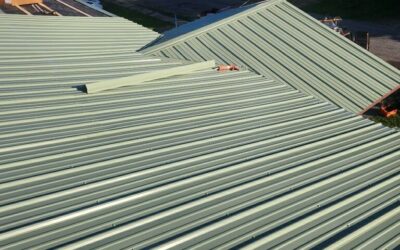Gable Roof vs. Hip Roof: The Differences Between Them
Introduction
When designing or renovating a home, the choice of roof style plays a crucial role in both aesthetics and functionality. Two of the most common roofing styles are gable roofs and hip roofs. Each offers unique advantages and drawbacks, making them suitable for different climates, architectural styles, and homeowner needs.
In this guide, we’ll compare gable and hip roofs in terms of design, benefits, drawbacks, cost, durability, and ideal applications. By the end, you’ll have a clear understanding of which roofing style is best for your home.
What Is a Gable Roof?
A gable roof is one of the most recognizable roof types, featuring two sloped sides that meet at a peak to form a triangular shape. This simple yet effective design makes gable roofs one of the most popular choices for residential and commercial buildings alike.
Characteristics of a Gable Roof
- Two Sloped Sides: The roof consists of two angled sections that slope downwards from a central ridge.
- Triangular Gable Ends: The walls beneath the roof form a triangular shape.
- Steep Pitch Options: Gable roofs can be designed with steep pitches to enhance water runoff and attic space.
- Common in Various Architectural Styles: Found in Colonial, Cape Cod, and modern home designs.
Pros of a Gable Roof
- Cost-Effective Construction
- Gable roofs require fewer materials and less labor, making them more budget-friendly compared to complex roof styles.
- Excellent Water and Snow Drainage
- The steep slopes allow rain and snow to easily slide off, preventing moisture buildup and potential leaks.
- Easy to Build and Maintain
- The simple design makes gable roofs easier to construct, repair, and maintain compared to intricate roofing structures.
- More Attic Space
- The design creates a spacious attic, allowing for better insulation, storage, or even an additional living area.
Cons of a Gable Roof
- Less Stable in High Winds
- Gable roofs are prone to wind damage, especially if not properly braced. Strong winds can uplift the eaves and cause structural failure.
- May Require Additional Reinforcement
- In hurricane-prone areas, extra bracing and secure anchoring are necessary to prevent wind-related damage.
- Gable Ends Can Be Vulnerable to Weather
- The large, flat gable ends can be more exposed to heavy rain and wind-driven moisture.
What Is a Hip Roof?
A hip roof, also known as a hipped roof, features slopes on all four sides, which meet at a ridge or a single peak. Unlike a gable roof, a hip roof has no vertical gable ends, making it more aerodynamic and structurally stable.
Characteristics of a Hip Roof
- Four-Sided Design: Each side of the roof slopes downward at a consistent angle.
- No Vertical Gable Ends: All sides have a slope, eliminating large, exposed wall sections.
- More Complex Structure: The design requires additional framing and materials compared to gable roofs.
- Common in Ranch, Mediterranean, and Cottage-Style Homes.
Pros of a Hip Roof
- Superior Wind Resistance
- The aerodynamic design makes hip roofs more stable in high-wind areas, such as hurricane-prone regions.
- Better Durability and Longevity
- With slopes on all sides, hip roofs distribute weight evenly, reducing stress on structural components.
- Enhanced Curb Appeal
- The sleek and symmetrical appearance adds aesthetic value to homes, enhancing resale appeal.
- Greater Roof Overhangs for Shade and Protection
- Hip roofs often have extended eaves, providing better sun and rain protection for windows, walls, and entryways.
Cons of a Hip Roof
- Higher Construction Costs
- Due to their complexity, hip roofs require more materials, labor, and time to build, making them more expensive.
- Reduced Attic Space
- Unlike gable roofs, hip roofs limit attic space because of their inward-sloping design.
- More Maintenance Required
- With additional seams and valleys, hip roofs may require more frequent inspections and maintenance to prevent leaks.
Gable Roof vs. Hip Roof: Side-by-Side Comparison
| Feature | Gable Roof | Hip Roof |
|---|---|---|
| Cost | More affordable | More expensive due to complex construction |
| Durability | Prone to wind damage | Highly wind-resistant and stable |
| Maintenance | Easier to maintain and repair | Requires more maintenance due to additional seams |
| Snow & Rain Drainage | Excellent drainage | Good drainage but may require additional waterproofing in valleys |
| Attic Space | More attic space for storage or living | Less attic space due to sloping sides |
| Aesthetic Appeal | Simple and classic | Elegant and sophisticated |
| Best Climate | Ideal for dry or snowy climates | Suitable for high-wind and hurricane-prone areas |
Which Roof Style Is Best for You?
The decision between a gable and hip roof depends on several factors, including your budget, climate, and aesthetic preferences.
- Choose a Gable Roof If:
- You want a cost-effective, easy-to-build roof.
- You live in an area with mild to moderate weather conditions.
- You need extra attic space for storage or expansion.
- Choose a Hip Roof If:
- You live in a hurricane or high-wind region and need extra durability.
- You prefer a more sophisticated, stylish appearance.
- You don’t mind the extra cost for long-term stability and protection.
Conclusion
Both gable and hip roofs offer distinct advantages and disadvantages, and the right choice depends on your specific needs and location. Gable roofs provide affordability and attic space, making them ideal for traditional homes in moderate climates. On the other hand, hip roofs offer superior wind resistance and a polished aesthetic, making them an excellent choice for areas prone to extreme weather.
At S&K Construction and Remodeling LLC, we specialize in high-quality roofing solutions tailored to your needs. Whether you’re looking for a sturdy hip roof or a classic gable roof, our team of experienced professionals can help. Contact us today for expert advice and a free consultation!
 (440) 307-2060
(440) 307-2060

